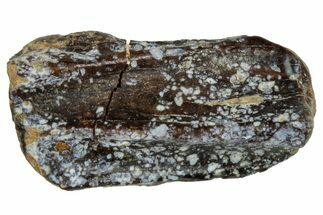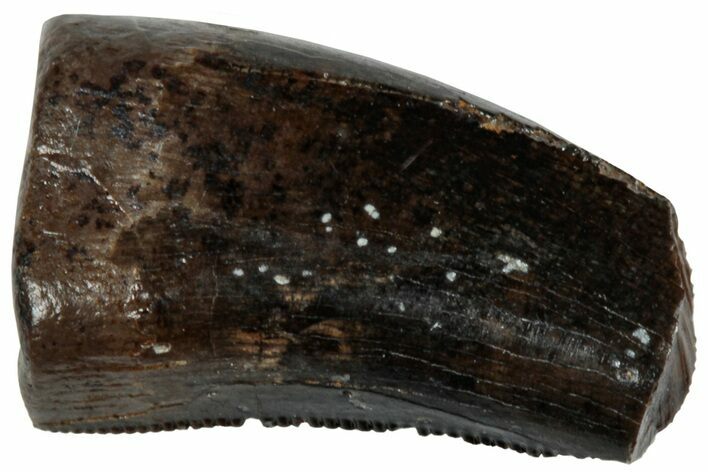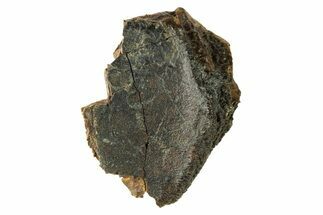This Specimen has been sold.
Serrated, .48" Tyrannosaur (Nanotyrannus?) Tooth - Wyoming
This is a .48" long tyrannosaur tooth likely of the species Nanotyrannus lancensis, collected from the Lance (Creek) Formation in Wyoming. The serrations along the distal edge are intact and the tip is missing.
Comes with an acrylic display case.
Comes with an acrylic display case.
Nanotyrannus vs. T-Rex
Paleontologists debate contentiously about whether Nanotyrannus and Tyrannosaurus rex (T-Rex) are really the same species, where Nanotyrannus represent juveniles. Papers going back and forth on the topic continue to be published, but even more fossil evidence under study has yet to be published. We tend to fall into the camp that Nanotyrannus is in fact a separate species.
No matter where you fall on the Nano vs T-Rex debate, there are clearly two different Tyrannosaur tooth morphologies present in the Hell Creek Formation. The larger teeth, usually 2 1/2 inches or more, can confidently be labeled as Tyrannosaurus rex. For the smaller teeth, main distinguishing characteristics between the two morphologies is the shape of the base, compression of the crown/tip, and presence of a "pinch" at the base. Serration density does not appear to be a distinguishing factor since it varies based on tooth position.
We are labeling based on morphology. The longer, thinner, and more compressed teeth with a pinch at their base are labeled as Nanotyrannus. The fatter teeth with a more rounded tip and no pinch at their base are labeled as Tyrannosaurus rex.
Paleontologists debate contentiously about whether Nanotyrannus and Tyrannosaurus rex (T-Rex) are really the same species, where Nanotyrannus represent juveniles. Papers going back and forth on the topic continue to be published, but even more fossil evidence under study has yet to be published. We tend to fall into the camp that Nanotyrannus is in fact a separate species.
No matter where you fall on the Nano vs T-Rex debate, there are clearly two different Tyrannosaur tooth morphologies present in the Hell Creek Formation. The larger teeth, usually 2 1/2 inches or more, can confidently be labeled as Tyrannosaurus rex. For the smaller teeth, main distinguishing characteristics between the two morphologies is the shape of the base, compression of the crown/tip, and presence of a "pinch" at the base. Serration density does not appear to be a distinguishing factor since it varies based on tooth position.
We are labeling based on morphology. The longer, thinner, and more compressed teeth with a pinch at their base are labeled as Nanotyrannus. The fatter teeth with a more rounded tip and no pinch at their base are labeled as Tyrannosaurus rex.
The Lance Formation of Wyoming, which dates back to the Late Cretaceous period between 66 and 69 million years ago, is home to a wide variety of both dinosaur and assorted small vertebrate fossils. During the Cretaceous, this midwestern formation would have been comprised of streams connected to the large Western Interior Seaway that split continental North America in half down the midwest. As a result of the subtropical climate and frequent rainfall, life flourished both on land and in the sea. These wet environments created perfect scenarios for sediment deposition, making the resulting Lance Formation such a fertile fossil site.
Perhaps the most famous Lance resident would be Tyrannosaurus rex, the largest North American carnivore to ever live. However, other smaller theropods also roamed the American midwest in this subtropical coastal stream system, including the beaked Ornithomimus, a lanky running theropod with a build similar to a modern ostrich, as well as several small predatory troodonts such as Paronychodon and Pectinodon.
Herbivorous dinosaurs also took advantage of the abundance offered by this unique era. Armored ankylosaurs dwelt in herds, their safety assured by their numbers, their heavy bone plating protecting most of their bodies and even their eyelids, and huge bone clubs on the ends of their tails providing them with powerful offensive capabilities. Ceratopsians like the famous Triceratops also formed protective herds, guarding their necks with frills and horns. Their smaller relatives, the dome-headed pachycephalosaurs, were also well represented in the area. Hadrosaurs, duck-billed titans with huge batteries of plant-grinding teeth in elongated snouts, are also well known from the region.
In addition to dinosaurs, a wide variety of fishes, amphibians, lizards, snakes, turtles, champsosaurs, crocodilians, and pterosaurs have been found in the formation.
Perhaps the most famous Lance resident would be Tyrannosaurus rex, the largest North American carnivore to ever live. However, other smaller theropods also roamed the American midwest in this subtropical coastal stream system, including the beaked Ornithomimus, a lanky running theropod with a build similar to a modern ostrich, as well as several small predatory troodonts such as Paronychodon and Pectinodon.
Herbivorous dinosaurs also took advantage of the abundance offered by this unique era. Armored ankylosaurs dwelt in herds, their safety assured by their numbers, their heavy bone plating protecting most of their bodies and even their eyelids, and huge bone clubs on the ends of their tails providing them with powerful offensive capabilities. Ceratopsians like the famous Triceratops also formed protective herds, guarding their necks with frills and horns. Their smaller relatives, the dome-headed pachycephalosaurs, were also well represented in the area. Hadrosaurs, duck-billed titans with huge batteries of plant-grinding teeth in elongated snouts, are also well known from the region.
In addition to dinosaurs, a wide variety of fishes, amphibians, lizards, snakes, turtles, champsosaurs, crocodilians, and pterosaurs have been found in the formation.
SPECIES
Nanotyrannus lancensis?
LOCATION
Wyoming
FORMATION
Lance (Creek) Formation
SIZE
.48" long (straightline)
CATEGORY
SUB CATEGORY
ITEM
#263418
We guarantee the authenticity of all of our
specimens. Read more about our
Authenticity Guarantee.
specimens. Read more about our
Authenticity Guarantee.
 Reviews
Reviews












